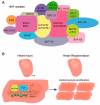Epigenetic Regulation of Organ Regeneration in Zebrafish
- PMID: 30558240
- PMCID: PMC6306890
- DOI: 10.3390/jcdd5040057
Epigenetic Regulation of Organ Regeneration in Zebrafish
Abstract
The zebrafish is broadly used for investigating de novo organ regeneration, because of its strong regenerative potential. Over the past two decades of intense study, significant advances have been made in identifying both the regenerative cell sources and molecular signaling pathways in a variety of organs in adult zebrafish. Epigenetic regulation has gradually moved into the center-stage of this research area, aided by comprehensive work demonstrating that DNA methylation, histone modifications, chromatin remodeling complexes, and microRNAs are essential for organ regeneration. Here, we present a brief review of how these epigenetic components are induced upon injury, and how they are involved in sophisticated organ regeneration. In addition, we highlight several prospective research directions and their potential implications for regenerative medicine.
Keywords: DNA methylation; SWI/SNF complex; histone modification; miRNA; regeneration; zebrafish.
Conflict of interest statement
The authors declare no conflict of interests.
Figures


Similar articles
-
Paradoxical Changes Underscore Epigenetic Reprogramming During Adult Zebrafish Extraocular Muscle Regeneration.Invest Ophthalmol Vis Sci. 2019 Dec 2;60(15):4991-4999. doi: 10.1167/iovs.19-27556. Invest Ophthalmol Vis Sci. 2019. PMID: 31794598 Free PMC article.
-
Epigenetic Regulator Signatures in Regenerative Capacity.Curr Stem Cell Res Ther. 2019;14(7):598-606. doi: 10.2174/1574888X14666190618125111. Curr Stem Cell Res Ther. 2019. PMID: 31244431 Review.
-
Differential Expression of SWI/SNF Chromatin Remodeler Subunits Brahma and Brahma-Related Gene During Drug-Induced Liver Injury and Regeneration in Mouse Model.DNA Cell Biol. 2016 Aug;35(8):373-84. doi: 10.1089/dna.2015.3155. Epub 2016 Apr 20. DNA Cell Biol. 2016. PMID: 27097303
-
Expression patterns of dnmt3aa, dnmt3ab, and dnmt4 during development and fin regeneration in zebrafish.Gene Expr Patterns. 2014 Mar;14(2):105-10. doi: 10.1016/j.gep.2014.01.005. Epub 2014 Feb 6. Gene Expr Patterns. 2014. PMID: 24509247
-
Regulation of Plant Growth and Development: A Review From a Chromatin Remodeling Perspective.Front Plant Sci. 2018 Aug 22;9:1232. doi: 10.3389/fpls.2018.01232. eCollection 2018. Front Plant Sci. 2018. PMID: 30186301 Free PMC article. Review.
Cited by
-
Epigenetic Cross-Talk Between Sirt1 and Dnmt1 Promotes Axonal Regeneration After Spinal Cord Injury in Zebrafish.Mol Neurobiol. 2025 Feb;62(2):2396-2419. doi: 10.1007/s12035-024-04408-w. Epub 2024 Aug 7. Mol Neurobiol. 2025. PMID: 39110393
-
Regenerative Potential of Injured Spinal Cord in the Light of Epigenetic Regulation and Modulation.Cells. 2023 Jun 22;12(13):1694. doi: 10.3390/cells12131694. Cells. 2023. PMID: 37443728 Free PMC article. Review.
-
Advances in Cardiac Development and Regeneration Using Zebrafish as a Model System for High-Throughput Research.J Dev Biol. 2021 Sep 25;9(4):40. doi: 10.3390/jdb9040040. J Dev Biol. 2021. PMID: 34698193 Free PMC article. Review.
-
DNA demethylation is a driver for chick retina regeneration.Epigenetics. 2020 Sep;15(9):998-1019. doi: 10.1080/15592294.2020.1747742. Epub 2020 Apr 14. Epigenetics. 2020. PMID: 32290791 Free PMC article.
-
Endothelial Brg1 fine-tunes Notch signaling during zebrafish heart regeneration.NPJ Regen Med. 2023 Apr 7;8(1):21. doi: 10.1038/s41536-023-00293-4. NPJ Regen Med. 2023. PMID: 37029137 Free PMC article.
References
Publication types
Grants and funding
LinkOut - more resources
Full Text Sources
Miscellaneous

